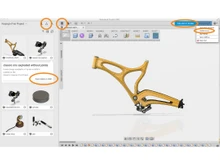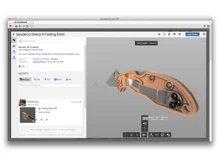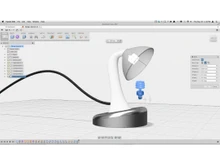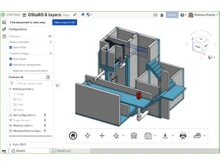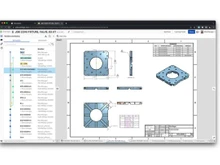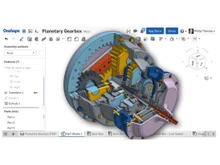How are Onshape and Autodesk Fusion 360 Different?
Onshape is entirely cloud-based, which makes it a better choice for teams who require continuous access to designs from anywhere, anytime. It is perfect for fast-paced teams or companies with numerous stakeholders because of its real-time collaboration features and device compatibility. The robust cloud functionalities help users to worry less about data loss, backups, or file syncing.
In contrast, Fusion 360 provides both offline and cloud-based functionality. One advantage for people who work in settings where an internet connection isn't always available is that you can design offline. Fusion 360 ensures that your data is backed up and accessible on multiple devices by syncing your work to the cloud once connected.
Comparison Table: Onshape vs Fusion 360
| Onshape vs Fusion 360 Comparison |
| Feature |
Onshape |
Fusion 360 |
| Platform |
Fully cloud-based |
Hybrid; Cloud with desktop offline use |
| Design and Modelling |
Parametric, direct modelling, assembly design |
CAD, CAM, rendering, simulation |
| Simulation & Testing |
Limited |
Extensive |
| Manufacturing Suite |
No built-in suite, supports integrations |
Fully integrated suite for manufacturing |
| CAM Tools |
Third-party integrations (e.g., CAMWorks) |
Full native CAM tools, cloud collaboration |
| Performance |
Strong, depends on internet speed |
Strong, hardware dependent |
| UI Design |
Modern web interface |
Traditional desktop, modern cloud version |
| Learning Curve |
Easy to learn |
Steeper due to broader toolset |
| Collaboration |
Real-time multi-user collaboration |
Cloud collaboration, manual file sharing |
| Plug-ins & Integration |
Limited, API support for third-party apps |
Extensive plug-ins, Autodesk ecosystem |
| Popular Use Cases |
Cloud-based projects, automotive, aerospace |
Mechanical design, manufacturing, 3D printing |
| Platform Compatibility |
Windows, macOS, Linux (web-based) |
Windows, macOS (desktop and cloud) |
| 24/7 Support |
Available |
Not Available |
| Licensing & Cost |
Starting from $1500 pu/pm |
Starting from ₹5,900 pu/pm |
Detailed Feature Comparison of Onshape vs Autodesk Fusion
Sketching Toolbar and Library
The sketching toolbar in Onshape offers a range of tools for making 2D sketches in a clear, user-friendly interface with effective controls for dimensions and limitations. Because of its large library, users can add common features like bolts, nuts, and other parts. Additionally, Autodesk Fusion 360 provides a flexible sketching environment with a wide range of sketching and restricting tools. Despite being similar, Fusion 360's sketch library is more geared towards parametric design aspects and frequently works more smoothly with the 3D modelling workflow, which makes it perfect for iterative design processes.
3D Modeling Tools
With a focus on solid modelling, surface modelling, and sheet metal design, Onshape offers an advanced suite of parametric modelling tools that function effortlessly in a cloud context. Its toolset can cater to both basic and complex elements. However, Autodesk Fusion 360's combination of parametric, direct, and freeform modelling capabilities makes it superior. Fusion 360 is perfect for users with a variety of design demands. From mechanical parts to organic designs, it provides better sculpting tools, sheet metal design, and the option to transition between different modelling techniques.
Modification, Inspection and Simulation
A wide range of modification tools are available in Onshape, such as patterning, fillets, chamfers, and dimension modifications. Onshape's integration with cloud-based simulation tools such as SimScale provides real-time performance analysis. On the other hand, the integrated simulation features of Autodesk Fusion 360, such as motion studies, temperature simulation, and stress analysis, are noteworthy for designers. It is an excellent tool for engineers seeking thorough simulation without the need for third-party software. This CAD software also has capabilities for direct customisation and inspection, like interference checking.
Render and Animation
Although Onshape has good rendering capabilities, it doesn't have as many possibilities as Fusion 360. Basic renderings can be done by users, however complex visualisations can require the use of third-party apps. In contrast, high-quality rendering techniques are available in Autodesk Fusion 360, including physically realistic materials and sophisticated lighting. Additionally, it has animation capabilities for product assembly movements, providing a complete solution for motion simulations and realistic renders in the same setting.
Assembly Tools
In order to ensure that components fit together exactly in 3D space, Onshape's assembly features allow you to insert components and specify mate connections. This CAD software supports real-time updates, easy collaboration and allows motion analysis. A variety of assembly tools are also available in Autodesk Fusion 360, such as joints that specify how parts interact and motion simulations. Large assemblies can be supported by Fusion 360's stable assembly environment. It also provides improved capabilities and contact sets for fine-tuning restrictions and modelling real-world movement between parts.
Manufacturing Suite
Primarily, Onshape integrates its manufacturing capabilities through its cloud-based platform and third-party partner apps. In contrast to Fusion 360, Onshape lacks some advanced features but enables sheet metal design, CNC machining, and additive manufacturing. One of Autodesk Fusion 360's most notable features is its manufacturing suite, which includes extensive capabilities for sheet metal fabrication, 3D printing, laser cutting, and CNC machining. Autodesk Fusion offers a more cohesive solution for users engaged in both design and production by enabling end-to-end manufacturing, from design to toolpath development.
Collaboration and Commenting
Because Onshape is cloud-based, it works well in collaborative settings where several people can work on a project at once. Team members can communicate directly within the model, track changes, and offer feedback thanks to its integrated commenting system. Autodesk Fusion 360 provides cloud integration for collaboration. However, it does not include Onshape's real-time collaborative environment. Users must handle comments and feedback via a more conventional file-based review method, even if it enables versioning and cloud storage.
History, Version Control and Branching
One of Onshape's advantages is its version control, which provides a thorough version history and the option to construct branches for concurrent development. Users can go back to any earlier state, and changes are automatically logged in real time. A comparable versioning system is offered by Autodesk Fusion 360, though it depends more on manual version saving and cloud syncing. Onshape's version and branch management system is more efficient and tailored for collaborative, real-time processes, even though it does offer branching in some way.
UI & Learning Curve
The user interface of Onshape is simple and straightforward, making it very easy to use. However, for people who are not accustomed to online CAD tools or cloud computing, the initial learning curve may be higher due to its cloud-based nature. The more complicated user interface (UI) of Fusion 360 may be intimidating at first for some users. It combines multiple design and manufacturing tools into one area. But for new users that put in the effort to master the software, the learning curve is reasonable, thanks to the abundance of tutorials and learning materials it offers.
Plug-ins and Integrations
Many third-party app integrations are supported by Onshape, especially through its App Store, which offers connectors for CAD improvements, simulations, and renderings. Its network of plugins isn't as vast as Fusion 360's, though. Autodesk Fusion 360 offers users greater customisation options and expands capabilities. It has a vast library of plugins and integrations with third-party apps, CAM tools, and other Autodesk products. This tool is better suited to a variety of industrial and design requirements due to its extensive integrations.
System Requirements
As Onshape's cloud-based model does all the hard lifting on distant servers, it drastically lowers system requirements. It is more accessible on a variety of platforms because users only need a device with an internet connection and a contemporary browser to use it. Because Autodesk Fusion 360 is a desktop program that integrates with the cloud, it needs a more powerful system to function properly, particularly for larger projects. To guarantee that its modelling and simulation tools run smoothly, it needs certain hardware, including a multi-core processor, 8GB of RAM, and a suitable graphics card.
Autodesk Fusion 360 vs Onshape: Pricing
Onshape offers a free version for individual use, but its professional plans can be more expensive than Fusion 360’s subscription model. Fusion 360 offers a more flexible pricing structure, including a free version for students and startups.
Onshape’s pricing starts from $1,500 pu/pm for the Starter Plan; $2,500 pu/pm for the Professional Plan; an Enterprise-level plan is available on request. Whereas Autodesk only offer a single plan on a monthly and annual basis, i.e., ₹5,900 pu/pm, billed monthly and ₹46,020 for a full year per user at one-time pay. Above mentioned prices may vary if you opt different mode of payment or choose to avail discounts.
Which is Better—Onshape or Autodesk Fusion?
Teams who value cloud-based workflows and real-time collaboration should choose Onshape. Onshape is the best option if you need version control, easy cloud access, and the flexibility to work from any device.
For users that require a complete CAD solution that combines design, simulation, and manufacturing, Fusion 360 is the right solution. Those working in product development and manufacturing who require advanced simulation features and offline functionality will especially benefit from it.
You can test out both platforms and see which one best suit your needs as an individual user.
For further product-related queries, please reach out to our Techjockey Team.


 23 Ratings & 23 Reviews
23 Ratings & 23 Reviews























